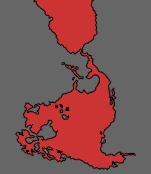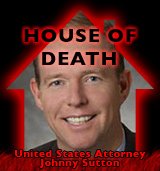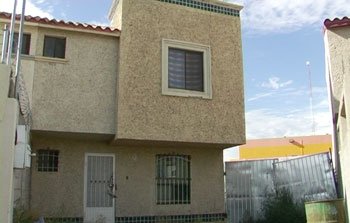


Tracking the Bloody Footprints in the House of Death: Part I

A Diary of U.S.-Backed Mass Murder in Mexico
By Bill Conroy
Special to The Narco News Bulletin
December 8, 2005
The House of Death looks like a typical middle-class home tucked in a residential neighborhood in the Mexican border town of Ciudad Juárez, across the Rio Grande from El Paso, Texas.
But in reality, it is a portal into the shadowy world of narco-trafficking, a crossroads where torture and murder were carried out by ruthless thugs, including corrupt Mexican law enforcers.
 The House of Death in Ciudad Júarez, Mexico Photo: D.R. 2005 Klaas Wollstein |
Between August 2003 and mid-January of 2004, a dozen people were kidnapped, tortured and butchered at the House of Death in Juárez with the help of a U.S. government informant—who was under the watch of U.S. Immigration and Customs Enforcement (ICE) agents and an Assistant U.S. Attorney in El Paso.
When the informants role came to light, after his activities nearly cost the lives of a DEA agent and his family, rather than investigate the callous activities of U.S. law enforcers who allowed the informant to commit murder under government cover, the leadership of the U.S. Department of Justice and Department of Homeland Security, which oversees ICE, chose to bury the facts along with the bodies.
A cover-up was hatched, that continues to this day, and the high-ranking DEA agent, Sandalio Gonzalez, who blew the whistle on the whole sordid affair, became yet another victim of the House of Death—his career ruined in the aftermath of a calculated effort to silence the messenger.
For those of you who have been following this story on Narco News over the past year and a half, this narrative line is nothing new. Still, despite all the information now out there, the bloodbath in the House of Death remains in the shadows of a cover-up. And based on public documents, as many of you now know, that cover-up reaches all the way to the top of the Department of Justice.
But what has not been laid out to this point is the sequence of events, and the description of some of the key players, who acted out this tragic drug-war farce. Over the past several months, with the help of multiple sources and by piecing together information from a variety of documents, Narco News has created a diary, of sorts, that traces the events and background of the House of Death mass-murder case.
The diary is based loosely (and at times paraphrases or draws directly from) an actual timeline of events developed by the DEA in the days immediately following the evacuation of its agents from Juárez—after those agents had been compromised by the narco-traffickers, the informant (and the actions of ICE agents) connected to the House of Death.
So grab a cozy chair and settle back into the seat as you read this diary, but remember to keep the lights on with this one.
House of Death Diary: Part I
Nov. 8, 2001: A DEA investigation has determined that Heriberto Santillan-Tabares controls the Ciudad Juárez operations of the Vicente Carrillo-Fuentes narco-trafficking organization. His second in command is an ex-Mexican Federal de Caminos Highway Patrol Officer who lives in El Paso. Unbeknownst to the DEA at this time, this ex-Mexican Highway Patrol cop is being employed as an informant for U.S. Customs (a predecessor agency to ICE). This informant, codenamed Jesus Contreras, is directing marijuana shipments in El Paso from Juárez with the assistance of a corrupt U.S. immigration inspector.
Jan. 10, 2002: The corrupt inspector is arrested, forcing Contreras to adjust his smuggling strategy. The DEA gets a tip providing them with the telephone numbers being used by Contreras, and subpoenas those records, which allows DEA to track Contreras activities in El Paso.
July 11, 2002: DEA, using its own informants and agent resources, opens a case on Santillan and Contreras still not aware, at this time, that Contreras is working as an informant for ICE. However, once an official investigation is opened, and ICE becomes aware of this fact, DEA is clued into the fact that Contreras is an ICE asset. ICE allows DEA to debrief Contreras at that point. Both ICE and DEA then continue to run Contreras as an informant in the Santillan investigation.
Oct. 16, 2002: Contreras identifies additional individuals who are working with Santillan. He also confirms that individuals in the Chihuahua State Police are controlled by the Vicente Carrillo-Fuentes organization (VCFO). Contreras claims that there is only one person in the chain of command between Santillan and Carrillo-Fuentes himself. DEA recommends that their Mexican law enforcement counterparts be let in the loop concerning the information being supplied by Contreras. ICE refuses and requests, consistently, that DEA not share any information with the Mexican government.
The informant Contreras has a close relationship with Santillan, who is a big-time cocaine and marijuana smuggler operating in the Mexican states of Chihuahua, Durango and Torreon and affects trafficking activity in Texas, Illinois and elsewhere. Santillan also serves as an enforcer for the VCFO, assuring territorial control of the Juárez/West Texas corridor. He does this by overseeing the stealing of drugs, kidnappings and murders of rival traffickers who have not been cleared to run loads within the corridor.
Nov. 13, 2002: The informant Contreras fingers Miguel Loya-Gallegos as being an associate of Santillan. Loya is a night-shift commander for the Chihuahua State Police in Juárez. He is charged with overseeing and directing enforcement activities, such as murders, for Santillan and the VCFO. The informant also indicates that Carrillo-Fuentes himself frequents several ranches near Gomez Palacio, Durango, Mexico. He also tells his DEA and ICE handlers that a relative of Carrillo-Fuentes lives in El Paso.
Jan.March, 2003: A multi-agency task force called Operation Skyhigh is organized in El Paso. It includes DEA, ICE, FBI and Mexican federal law enforcers. Despite this commitment to bilateral cooperation in Skyhigh, ICE continues to ask that DEA not share any information obtained from the informant Contreras with Mexican law enforcers.
March 7, 2003: The informant identifies a former Chihuahua State Police officer as a contact for a number of narco-trafficking groups, including one headed by Armando Corral-Olaquez. Contreras also tells his handlers that Santillan came across the border in February 2003 because of a death in his family and supposedly stayed at a hotel on Airway Boulevard in El Paso.
March 10, 2003: DEA finds a vehicle that was used by Santillans supervisor in the VCFO, who is known as El Comandante, at a hotel in El Paso. ICE agents also come to the scene and participate in surveillance. The El Paso County Sheriffs office, in coordination with DEA, are able to determine that El Comandante lives in Monterrey/Coahuila and allegedly is a former Mexican Federal Police Commander.
March 25, 2003: The informant Contreras lines up a drug deal for Santillan. Contreras is provided with 29 kilos of coke, which he turns over to ICE and DEA to undertake a controlled delivery a sting. The coke is concealed in a hidden compartment in a 1999 Dodge Intrepid and delivered by a DEA undercover agent to a residence in Hereford, Texas. Surveillance is initiated on the house, during which time another Dodge Intrepid is seen leaving the residence. Subsequently, that vehicle is pulled over and its three occupants arrested after a search uncovers the 29 kilos of coke and $18,000 in cash. (This sting is used as the basis for issuing an indictment against Santillan in December 2003.)
April 7, 2003: The informant Contreras provides his agent handlers with a home address in Durango, Mexico, for Santillan and his wife.
June 23, 2003: Santillan provides Contreras with a telephone number to a safe house in Juárez. The house is used as a residence and meeting site by Santillan when he is in Juárez. DEA again recommends that Mexican law enforcers be brought into the loop to target Santillans safe house in Juárez. ICE continues to refuse to cooperate with the Mexican law enforcers, fearing it will compromise their informant and the case.
June 28, 2003: The informant Contreras is arrested by U.S. Border Patrol after attempting to smuggle 100 pounds of marijuana across the border.
June 30, 2003: ICE informs DEA of the informants arrest. ICE indicates that Contreras was simply trying to work his way into the network of another narco-trafficker, but did not have time to let ICE or DEA know about the plan. DEA immediately terminates its informant relationship with Contreras.
July 2, 2003: Contreras is released from jail and debriefed by his ICE handlers. ICE decides that it will continue to work with Contreras as an informant.
Aug. 5, 2003: The informant participates in the torture and murder of the first homicide victim in the House of Death. The murder involves a conspiracy between Contreras and Santillan, and others, to steal about a 1,000 pounds of marijuana from the individual (Fernando). Contreras poses as a drug mule who is offering to move the dope across the border and deliver it to Fernandos contacts.
Santillan drives Fernando to the House of Death, located at Calle Parsioneros 3633 in Juárez. Fernando, at the time, had no idea of the fate that awaited him. After Fernando enters the house, Santillan left the location. Contreras was waiting for Fernando inside the House of Death, along with the caretaker for the house and two Chihuahua State Police officers. Together, they tortured and murdered Fernando.
In the wake of the murder, the informant Contreras left the House of Death and hooked up with Santillan, indicating to him that he had left another individual with the responsibility of disposing of Fernandos body. Then Contreras returned to El Paso and met with his ICE handlers. Later in the evening, Contreras again returned to the House of Death in Juárez. The caretaker of the residence showed Contreras where the body was buried (in the backyard of the house). Contreras then paid the caretaker $2,000. (Contreras, who was carrying a concealed tape recorder, recorded Fernandos murder. That recording was provided to ICE.)
Aug. 6, 2003: ICE notifies DEA officials that Contreras had witnessed a murder, but did not indicate he had actually participated in the torture/homicide. DEA indicates that ICE should immediately notify the Mexican government of the details.
Aug. 7, 2003: ICE agents inform DEA agents in Juárez about Fernandos murder. A description of the location of the House of Death is given to the DEA agents in Juárez. However, that description is very vague, and proves useless in determining the actual location of the house. DEA asks that the informant return to Juárez to obtain more precise coordinates for the house, but ICE refuses to allow this to occur, indicating that they fear such a mission would put Contreras life in jeopardy.
Aug. 15, 2003: ICE informs Mexican authorities via a letter that Contreras witnessed a murder in Juárez during the course of a narco-trafficking investigation. ICE also asks that the informant Contreras be allowed to continue working in Mexico to advance the investigation and to help locate the body of the murder victim. ICE assures the Mexican authorities that they will be kept in the loop and that the informant would be made available for debriefing after the investigation is concluded.
Dec. 10, 2003: A criminal indictment is issued against Santillan. The indictment is returned by a federal grand jury in the Western District of Texas, which is overseen by U.S. Attorney Johnny Sutton in San Antonio. (By this point, with the help of ICE’s informant, some eight additional people have already been tortured and murdered in the House of Death.)
Dec. 19, 2003: The ICE office in El Paso submits a plan to ICE Headquarters in Washington detailing a strategy to lure Santillan across the border for arrest.
Read Part II of this series here.
- The Fund for Authentic Journalism
For more Narco News, click here.




